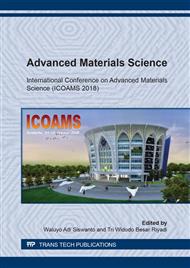[1]
Badan Pusat Statistik, Land Transportation Statistics, BPS, Jakarta, (2017).
Google Scholar
[2]
M. R. Ibrahim, H. Y. Katman, M. R. Karim, S. Koting, N. S. Mashaan, A review on the effect of crumb rubber addition to the rheology of crumb rubber modified bitumen, Adv. Mater. Sci. Eng. 2013 (2013) 1-9.
DOI: 10.1155/2013/415246
Google Scholar
[3]
J. Shen, S. Amirkhanian, The influence of crumb rubber modifier ( CRM ) microstructures on the high temperature properties of CRM binders The influence of crumb rubber modifier (CRM) microstructures on the high temperature properties of CRM binders, Int. J. Pavement Eng. 6, no. 4 (2007) 37-41.
DOI: 10.1080/10298430500373336
Google Scholar
[4]
H. Siswanto, B. Supriyanto, Pranoto, P. R. Chandra, A. R. Hakim, Marshall properties of asphalt concrete using crumb rubber modified of motorcycle tire waste, in AIP Conference Proceedings, 1887 (2017) 020039 1-5.
DOI: 10.1063/1.5003522
Google Scholar
[5]
H. Siswanto, B. Supriyanto, L. Abid, Water Resistance Evaluation of Asphalt Concrete Wearing Course Made with Crumb Rubber of Motorcycle Tire Waste, Appl. Mech. Mater. 845, (2016) 404–407.
DOI: 10.4028/www.scientific.net/amm.845.404
Google Scholar
[6]
H. Siswanto, B. Supriyanto, P. Pranoto, P. Rizky Chandra, A. Rahman Hakim, Evaluation of moisture damage in asphalt concrete with CRM motorcycle tire waste passing #50 sieve size, AIP Conf. Proc.1887 (2017) 020075 1-6.
DOI: 10.1063/1.5003558
Google Scholar
[7]
H. H. Kim, M. Mazumder, M. Lee, S. Lee, Effect of blending time on viscosity of rubberized binders with wax additives, Int. J. Pavement Res. Technol. 11 no.6 (2018) 655–665.
DOI: 10.1016/j.ijprt.2018.03.003
Google Scholar
[8]
B. Lebreton, A. Tuma, A quantitative approach to assessing the profitability of car and truck tire remanufacturing, Int. J. Prod. Econ. 104, no. 2 (2006) 639–652.
DOI: 10.1016/j.ijpe.2004.11.010
Google Scholar
[9]
K. Youngdae, H. Hwang, Efficient Operation Policy in a Closed-loop Tire Manufacturing System with EPR, Effic. Oper. Policy a Closed-loop Tire Manuf. Syst. with EPR, 8, no. 3 (2009). 162–170.
Google Scholar
[10]
N. Oikonomou, S. Mavridou, Improvement of chloride ion penetration resistance in cement mortars modified with rubber from worn automobile tires, Cem. Concr. Compos. 31, no. 6 (2009) 403–407.
DOI: 10.1016/j.cemconcomp.2009.04.004
Google Scholar
[11]
R. S. 03 1737-1989, Pedoman Pelaksanaan Lapis Campuran Beraspal Panas - Revisi SNI 03 1737-1989, BSN, Jakarta, (2005).
Google Scholar
[12]
R. M-01-2003, Metode Pengujian Campuran Beraspal Panas dengan Alat Marshall, BSN, Jakarta, (2003).
Google Scholar
[13]
Departemen Pekerjaan Umum, Spesifikasi Umum Bidang Jalan dan Jembatan Divisi 6, Revisi 1, BSN, Jakarta, (2010).
Google Scholar
[14]
Y. M. Dong, Y. Q. Tan, Laboratory Evaluation on Performance of Crumb Rubber SMA, Adv. Mater. Res. 168–170 (2010) 1749–1755.
DOI: 10.4028/www.scientific.net/amr.168-170.1749
Google Scholar
[15]
Suhardi, P. Pratomo, H. Ali, Study of Marshall Characteristics due to Asphalt Mixture with the Addition of Plastic Bottle Waste, J. Civ. Eng. Des.4, no. 2 (2016) 284–293.
Google Scholar
[16]
D. Sutradhar, M. Miah, G. J. Chowdhury, M. A. Sobhan, Effect of Using Waste Material as Filler in Bituminous Mix Design, Am. J. Civ. Eng. 3, no. 3 (2015) 88-94.
Google Scholar
[17]
P.E. Purnamasari, F. Suryaman, Effect of Using Plastic Bottle Waste as Additional Materials to Characteristic of Asphalt Concrete Layers (LASTON), Natl. Civ. Eng. Conf. 4, KoNTekS 4, (2010)397-404.
Google Scholar


